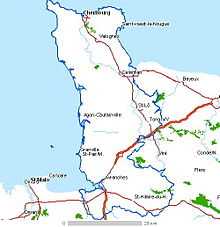Fortress Europe

Fortress Europe (German: Festung Europa) was a military propaganda term from the Second World War which referred to the areas of Continental Europe occupied by Nazi Germany, as opposed to the United Kingdom across the Channel. The term was used by both sides but, due to their respective geographic locations, in a very different sense.
In British phraseology, Fortress Europe meant the battle honour accorded to Royal Air Force and allied squadrons during the Second World War, but to qualify, operations had to be made by aircraft based in the British Isles against targets in Germany, Italy and other parts of Nazi-occupied Europe, in the period from the fall of France to the Normandy invasion.
World War II defenses
Simultaneously, the term Festung Europa was being used by Nazi propaganda, namely to refer to Hitler's and the Wehrmacht's plans to fortify the whole of occupied Europe, in order to prevent invasion from the British Isles. These measures included the construction of the Atlantic wall, along with reorganization of the Luftwaffe for air defense. This use of the term Fortress Europe was subsequently adopted by correspondents and historians in the English language to describe the military efforts of the Axis powers at defending the continent from the Allies.
Modern times

Currently, within Europe, the most common use of the term is as a pejorative description of the state of immigration into the European Union. This can be in reference either to attitudes toward immigration, or to the system of border patrols and detention centers that are used to help prevent illegal immigration into the European Union.[1]
For conservative parties (e.g. The Freedom Party of Austria) 'Fortress Europe' is a positive term. They mostly claim that such a fortress does not really exist yet, and that illegal immigrants can enter Europe far too easily. They often charge the southern states with insufficient border control, claiming that the latter are acting on the knowledge that immigrants are tendentially more attracted to western/northern states with more generous welfare systems (Switzerland, Germany, Austria, Sweden, etc.). Conservatives all over Europe want to end the Schengen Agreement and to re-install border controls because they say it did not only lead to mass migration of illegals but also to free traffic of criminals.[2] Changes in the Schengen treaties have come into effect in the wake of this criticism.[3]
Mayda, analyzing OECD data regarding the economic determinants of immigration, found that "pull" factors such as the generosity of the destination country's welfare system were more decisive than "push" factors such as domestic unrest in determining immigrants' choice of a destination, which had no statistically significant effects.[4] In his book "Germany Abolishes Itself," the prominent Social Democrat Thilo Sarrazin wrote that, "Whoever immigrates into Germany is taken care of regardless of their own initiative and readiness to achievement."[5] This claim is supported by findings showing that German residents with immigrant backgrounds received social support payments at a rate equal 420% of that of native Germans.[6]
Support for the concept of a Fortress Europe tends to be stronger among the lower economic classes, who face stronger competition from the workers with relatively low qualifications who form the majority of the migration flow into Europe. A team of European economic researchers has drawn attention to the fact that concern about immigration is stronger among the economically well-to do, i.e. those who employ maids and eat our more frequently than the average consumer.[7]
Controlled external borders
- Ceuta and Melilla (Morocco)
- Italian and Maltese coast
- Canary Islands (from Morocco)
- Maritsa (Turkey)
- Easter border of the European Union
- Albania
- Strait of Gibraltar (Morocco)
See also
- Hindenburg Line, German defences on the Western Front of World War I
- Siegfried Line, German defences against France in World War II
- Maginot Line, French defenses against Germany constructed for World War II
- Iron Curtain, dividing line through Europe during the Cold War
References
- ↑ Indymedia.org: Autonomous rear Entrances to Fortress Europe?!
- ↑ http://thecitypaperbogota.com/news/an-end-to-schengen/
- ↑ http://www.telegraph.co.uk/news/worldnews/europe/eu/8511019/EU-moves-to-end-passport-free-Schengen-travel.html
- ↑ Mayda, Anna Marie. "International Migration: A Panel Data Analysis of the Determinants of Bilateral Flows." Journal of Population Economics. 3.24 (2007): p. 1249-74.
- ↑ Sarrazin, Deutschland schafft sich ab, 1. Aufl., München 2010, p. 321.
- ↑ Bender, Stefan and Seifert, Wolfgang. "Introduction." Immigration, Citizenship and the Welfare State in Germany and the US. Ed. Hermann Kurthen, Jürgen Fijalkowski and Gert G. Wagner. Stanford, Connecticut: JAI Press Inc, 1998. p. 3. Print.
- ↑ Brücker, Herbert, et. al.. "Economic Consequences of Immigration in Europe" Immigration and the Transformation of Europe. Comp. Craig A. Parsons, Timothy M. Smeeding. Cambridge: Cambridge University Press, 2006. p. 133. Print.
